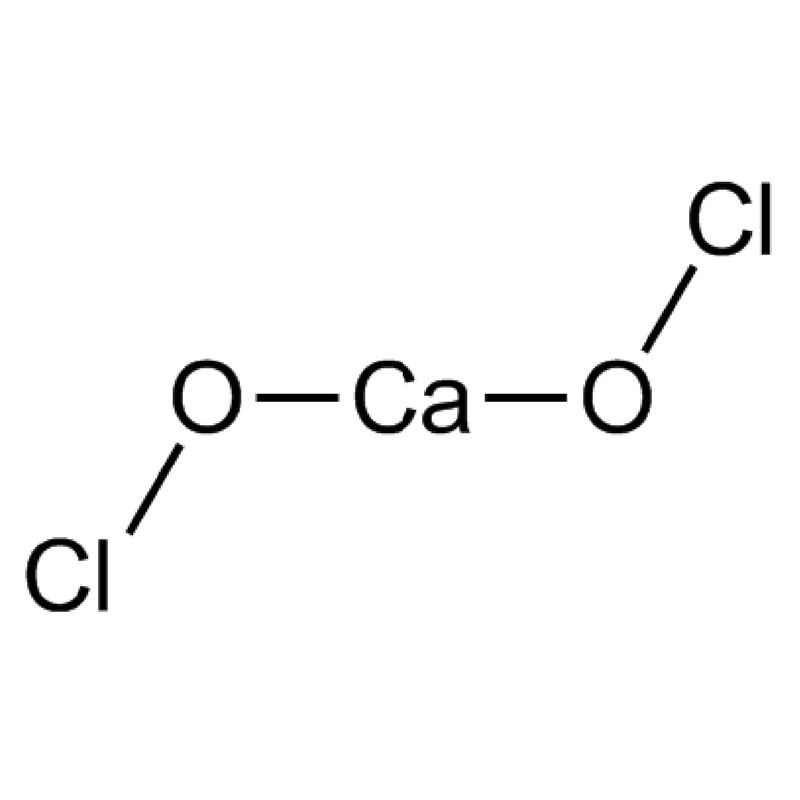Chemically, calcium hypochlorite has the formula Ca(ClO)2. It is a white or gray-white powder that is very water soluble. Being an oxidant, calcium hypochlorite may contribute oxygen atoms to other molecules, leading them to undergo oxidation.
Calcium Hypochlorite Molecule Structure
By looking at its chemical formula, it is possible to comprehend the molecular structure of calcium hypochlorite. One calcium cation (Ca2+) and two hypochlorite anions (ClO-) are the components of calcium hypochlorite, according to the formula. The hypochlorite anion has an overall negative charge and is made up of a chlorine atom (Cl) covalently bound to an oxygen atom (O). Due to the oxygen atom, the hypochlorite anion is very reactive, making it a potent oxidizing agent.
Contrarily, the calcium cation is positively charged and bigger than the hypochlorite anion. An ionic link is created between the calcium cation and the hypochlorite anion as a result of their different charges and sizes. The calcium hypochlorite's solid state and great solubility in water are both due to this ionic interaction.
Chemical composition of calcium hypochlorite
Calcium hypochlorite is helpful in a wide range of applications due to a number of its chemical characteristics. Its capacity to emit chlorine gas (Cl2) when combined with an acid, such as hydrochloric acid (HCl) or sulfuric acid (H2SO4), is one among its most recognized qualities. It is a potent oxidant and disinfectant due to its characteristic. When calcium hypochlorite dissolves in water, hypochlorous acid (HOCl), a weak acid that can be used as a disinfectant, is created.
Being able to break down when exposed to heat or light is another crucial quality of calcium hypochlorite. Chlorine gas (Cl2) and calcium chloride (CaCl2) are released as a result of this breakdown. The reaction's chemical equation is as follows:
Ca(ClO)2 → CaCl2 + Cl2
It is an exothermic process. The quantity of calcium hypochlorite that is broken down determines how much heat is emitted.
Exposure to light can hasten calcium hypochlorite's breakdown. This is due to the photon's ability to oxidize the light-sensitive hypochlorite anion. The end outcome is an oxidation process that produces chloride (Cl-) ions and oxygen atoms. This response may be expressed as follows:
2ClO- → 2Cl- + O2
By joining with other molecules, the oxygen atoms generated in this event can start an oxidation process. Calcium hypochlorite is a potent bleaching agent as a result of this characteristic.

Calcium hypochlorite applications
Numerous industrial and daily uses exist for calcium hypochlorite. As a water treatment disinfectant, it is one of its most popular applications. Hypochlorous acid (HOCl), a potent disinfectant, is produced when calcium hypochlorite is introduced to water. It works well against many different microorganisms, such as bacteria, viruses, and protozoa.
Calcium hypochlorite is also used as a bleaching agent in the textile industry. It is effective in removing stains and brightening fabrics. It is also used as a bleach for pulp, and as a disinfectant in the food industry to disinfect surfaces and equipment.

In addition, calcium hypochlorite is used in the manufacture of chlorinated compounds such as chloroform (CHCl3) and carbon tetrachloride (CCl4). These compounds are used as solvents, refrigerants and in the manufacture of plastics.
Calcium hypochlorite is also used in swimming pools and spas as a disinfectant to kill bacteria and algae. It is added to water in the form of granules or tablets, and slowly releases chlorine gas as it dissolves
In the textile sector, calcium hypochlorite is also employed as a bleaching agent. It works well to get stains out of clothes and make them seem brighter. Additionally, it is employed in the food business as a disinfectant to clean surfaces and equipment and as a bleach for pulp.
Additionally, calcium hypochlorite is employed in the production of chlorinated substances including carbon tetrachloride (CCl4) and chloroform (CHCl3). These substances are employed in the production of polymers as well as as solvents and refrigerants.
In order to destroy germs and algae, calcium hypochlorite is frequently used as a disinfectant in swimming pools and spas. It is added to water in the form of granules or tablets, and as it dissolves, it gradually releases chlorine gas.